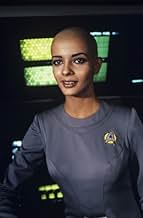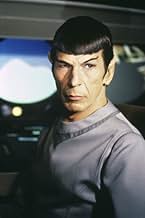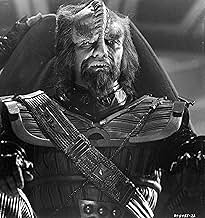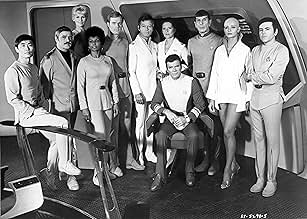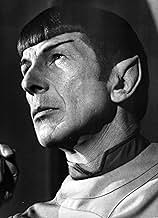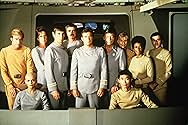जब अपरिचित एलियन क्लिंगन के तीन शक्तिशाली युद्धपोत नष्ट कर देता है तो कप्तान जेम्स टी कर्क (विलियम शेटनर) आधुनिक युएसएस एंटरप्राइज का संचालन सँभालने के लिए वापस लौटता है।जब अपरिचित एलियन क्लिंगन के तीन शक्तिशाली युद्धपोत नष्ट कर देता है तो कप्तान जेम्स टी कर्क (विलियम शेटनर) आधुनिक युएसएस एंटरप्राइज का संचालन सँभालने के लिए वापस लौटता है।जब अपरिचित एलियन क्लिंगन के तीन शक्तिशाली युद्धपोत नष्ट कर देता है तो कप्तान जेम्स टी कर्क (विलियम शेटनर) आधुनिक युएसएस एंटरप्राइज का संचालन सँभालने के लिए वापस लौटता है।
- निर्देशक
- लेखक
- स्टार
- 3 ऑस्कर के लिए नामांकित
- 4 जीत और कुल 20 नामांकन
John Gowans
- Assistant to Rand
- (as John D. Gowans)
फ़ीचर्ड समीक्षाएं
This DVD version has improved and restored and made Star Trek: TMP a pleasure to watch rather than a chore. You're less inclined to hit fast-forward in those lengthy scenes. This movie will resonate well with mature-age viewers because the story is not what you would expect from today's action packed cinema. I appreciated the movie more as I got older. Bob Wise explains on the DVD that production was extremely rushed and had no time to preview the film with an audience that would now after 20 years, tell him to tighten the opticals and emphasize characters. This is precisely what he has done in the DVD version and its magnificent.
Aesthetically, the DVD version shows you the best Star Trek: The Motion Picture can possibly look. Film is sharper; color is dead on however there is still a lot of film grain present unfortunately. My guess is they cleaned the original negative up as much as they could but it had deteriorated so much in storage, or was badly preserved. Certainly looks better than my bad pan/scanned VHS copy.
The DVD truly shines with its brand new sound mix. This isn't your standard stereo to 5.1 DVD conversions like they are doing for movies pre 5.1; they have gutted it up and added new stuff. The original release was so rushed that very little in terms of ambient sound and special effects audio elements were done on the sound mix amongst other production elements. For this DVD they went back to the original audiotapes and remixed them digitally.
Goldsmith's score sounded fantastic when it originally came out now sounds even better on the DVD version. It's tremendous, you will hear what your suppose to hear now with the added advantage of 5.1 surround sound. Goldsmith score truly has a chance to soar now by stretching into a clean high fidelity 5.1 environment rather than being squeezed onto a mono or stereo track. Bass kicks in often especially on big musical cues. You'll hear nifty panning and those surrounds and subwoofer will definitely get a workout. In instances they isolate different parts of the orchestra through different speakers, mainly the bass and percussion.
Most onstage dialog was re-recorded afterwards because of onstage noise due to mechanical devices etc; this is now common practice in the industry. The result is cleaner dialog that comes prominently out of your center speaker. The dialog audio is good, but on occasion it shows a mild muffled and tinny quality probably due to age of material or analog technology of the time, nevertheless I guarantee you, the average viewer will like it, I'm just being picky. In short the movie will sound almost as good as if the movie was made recently.
Not only having rebuilt the original audio they have put in more surround elements, like ambient bridge noises and computer voices. Not sure why they changed the `Intruder Alert' voice, I don't mind but I guess it was because they rushed the sound mix in the 70's and chose that voice as a last minute thing. There are other elements that have been changed, for the better I would say.
The DVD contents have been remastered with Wise's overseeing. There are too many subtleties to comment on so shall briefly discuss a few. Before opening credits you are treated to Goldsmiths V'ger/Love theme, a nice touch. Then you hear the bombastic Star Trek Theme. Newly done credits over moving starfield.
First main new special effect is the Vulcan landscape, tilting from sky to the surface. Then cuts to a new matte painting of the beautiful orange sky. Originally Spock shields his eyes and in the reversal, not only is there no sun there is little sky visible. The new matte painting now fits in nicely.
San Francisco sequence has been redone, 3 new matte paintings that better show the futurized city, Golden Gate Bridge and a bigger shuttlebay.
When they get into V'Ger they encounter a weapon heading towards them that is suppose to dissipate, in the original it simply disappears instantly, now we see a new visual that shows it dissipating just before it hits the ship.
Later we see a probe heading towards the ship on the viewscreen and then through some hokey editing it appears on the bridge. This has been replaced with an improved FX shot showing the approach of the entity on an exterior shot.
A new 'Wing Walk' sequence. Breathtaking new CGI's that show the away-team walk from the hull to the V'Ger stage, some using the original live action shots. New FXs for the most part are based on original storyboards. They didn't go overboard with the effects which is good, Bob tells us that they made FX that they could only do in the 1970's, unlike Star Wars whom George Lucas went overkill on new FX when he redid his in the 1990's.
There are trims, some rearrangements of shots for the better. E.g. Ilia/Deckers exchange of looks, Kirk's `Oh My God', his second `Viewer Off.' I suspect they had to edit within Jerry's score, or have to also edit Jerry's score to accommodate the new editing, if so they have done it very well, I couldn't notice. Some lengthy scenes remain in its entirety, e.g. flying up to the enterprise, I don't blame them for not trimming them, some are sentimental.
The 2 DVD's come with a plethora of information. Audio commentaries by the director, 2 special effect's guys, an actor and the composer guide you through the director's edition. Text commentary by Okuda gives even more scene specific info. Disc 2 gives you most of the trims, deleted scenes from the TV and Theatrical release not used in the DVD version and an outtake of an abandoned visual effect. Plus 3 documentaries about the abandoned TV series ST:Phase II, Directors edition DVD and the movie itself. Plus advertisements/trailers plus storyboards.
A MUST BUY FOR FANS! You'll Love It!
Aesthetically, the DVD version shows you the best Star Trek: The Motion Picture can possibly look. Film is sharper; color is dead on however there is still a lot of film grain present unfortunately. My guess is they cleaned the original negative up as much as they could but it had deteriorated so much in storage, or was badly preserved. Certainly looks better than my bad pan/scanned VHS copy.
The DVD truly shines with its brand new sound mix. This isn't your standard stereo to 5.1 DVD conversions like they are doing for movies pre 5.1; they have gutted it up and added new stuff. The original release was so rushed that very little in terms of ambient sound and special effects audio elements were done on the sound mix amongst other production elements. For this DVD they went back to the original audiotapes and remixed them digitally.
Goldsmith's score sounded fantastic when it originally came out now sounds even better on the DVD version. It's tremendous, you will hear what your suppose to hear now with the added advantage of 5.1 surround sound. Goldsmith score truly has a chance to soar now by stretching into a clean high fidelity 5.1 environment rather than being squeezed onto a mono or stereo track. Bass kicks in often especially on big musical cues. You'll hear nifty panning and those surrounds and subwoofer will definitely get a workout. In instances they isolate different parts of the orchestra through different speakers, mainly the bass and percussion.
Most onstage dialog was re-recorded afterwards because of onstage noise due to mechanical devices etc; this is now common practice in the industry. The result is cleaner dialog that comes prominently out of your center speaker. The dialog audio is good, but on occasion it shows a mild muffled and tinny quality probably due to age of material or analog technology of the time, nevertheless I guarantee you, the average viewer will like it, I'm just being picky. In short the movie will sound almost as good as if the movie was made recently.
Not only having rebuilt the original audio they have put in more surround elements, like ambient bridge noises and computer voices. Not sure why they changed the `Intruder Alert' voice, I don't mind but I guess it was because they rushed the sound mix in the 70's and chose that voice as a last minute thing. There are other elements that have been changed, for the better I would say.
The DVD contents have been remastered with Wise's overseeing. There are too many subtleties to comment on so shall briefly discuss a few. Before opening credits you are treated to Goldsmiths V'ger/Love theme, a nice touch. Then you hear the bombastic Star Trek Theme. Newly done credits over moving starfield.
First main new special effect is the Vulcan landscape, tilting from sky to the surface. Then cuts to a new matte painting of the beautiful orange sky. Originally Spock shields his eyes and in the reversal, not only is there no sun there is little sky visible. The new matte painting now fits in nicely.
San Francisco sequence has been redone, 3 new matte paintings that better show the futurized city, Golden Gate Bridge and a bigger shuttlebay.
When they get into V'Ger they encounter a weapon heading towards them that is suppose to dissipate, in the original it simply disappears instantly, now we see a new visual that shows it dissipating just before it hits the ship.
Later we see a probe heading towards the ship on the viewscreen and then through some hokey editing it appears on the bridge. This has been replaced with an improved FX shot showing the approach of the entity on an exterior shot.
A new 'Wing Walk' sequence. Breathtaking new CGI's that show the away-team walk from the hull to the V'Ger stage, some using the original live action shots. New FXs for the most part are based on original storyboards. They didn't go overboard with the effects which is good, Bob tells us that they made FX that they could only do in the 1970's, unlike Star Wars whom George Lucas went overkill on new FX when he redid his in the 1990's.
There are trims, some rearrangements of shots for the better. E.g. Ilia/Deckers exchange of looks, Kirk's `Oh My God', his second `Viewer Off.' I suspect they had to edit within Jerry's score, or have to also edit Jerry's score to accommodate the new editing, if so they have done it very well, I couldn't notice. Some lengthy scenes remain in its entirety, e.g. flying up to the enterprise, I don't blame them for not trimming them, some are sentimental.
The 2 DVD's come with a plethora of information. Audio commentaries by the director, 2 special effect's guys, an actor and the composer guide you through the director's edition. Text commentary by Okuda gives even more scene specific info. Disc 2 gives you most of the trims, deleted scenes from the TV and Theatrical release not used in the DVD version and an outtake of an abandoned visual effect. Plus 3 documentaries about the abandoned TV series ST:Phase II, Directors edition DVD and the movie itself. Plus advertisements/trailers plus storyboards.
A MUST BUY FOR FANS! You'll Love It!
Star Trek: The Motion Picture - Stardate: 7412.6
Of all the Star Trek films, this is the most impersonal and epic - which necessarily isn't a bad thing. This film really isn't about the Star Trek crew, but about the vast visual effects laden V'Ger and how the Enterprise spends 2+ hours exploring it. The score by Jerry Goldsmith only accentuates this epic-ness - this is one of his best scores and brings a majestic quality to the Star Trek crew. Never really is this film funny (unlike 4) or action-packed (unlike II) but regardless will always have a place in my heart because it tries to be as epic as Star Trek can possibly be. Overall, a 7 out of 10 (mostly because of the state-of-the-art effects of its time in 1979 and a superb score by Jerry Goldsmith RIP).
Of all the Star Trek films, this is the most impersonal and epic - which necessarily isn't a bad thing. This film really isn't about the Star Trek crew, but about the vast visual effects laden V'Ger and how the Enterprise spends 2+ hours exploring it. The score by Jerry Goldsmith only accentuates this epic-ness - this is one of his best scores and brings a majestic quality to the Star Trek crew. Never really is this film funny (unlike 4) or action-packed (unlike II) but regardless will always have a place in my heart because it tries to be as epic as Star Trek can possibly be. Overall, a 7 out of 10 (mostly because of the state-of-the-art effects of its time in 1979 and a superb score by Jerry Goldsmith RIP).
Boldly going where no man (or woman) has gone before, climb aboard the Enterprise and let it fly and soar, as old friends gather, reunite, off to battle and to fight, strange new worlds, civilisations to explore.
There's a cloud that's gathering in outer space, it's heading towards Earth at a great pace, starship Enterprise is sent, to discover its intent, gauge the power of the enemy that they face.
A reflective and contemplative piece reintroduces us to the crew of the starship Enterprise.
There's a cloud that's gathering in outer space, it's heading towards Earth at a great pace, starship Enterprise is sent, to discover its intent, gauge the power of the enemy that they face.
A reflective and contemplative piece reintroduces us to the crew of the starship Enterprise.
Star Trek: The Motion Picture was Paramount Studio's attempt at cashing in on the Star Wars craze that was sweeping through the late seventies. However, instead of getting a fast-paced action romp, they got something more in tune with 2001: A Space Odyssey. Therefore, the first big screen Star Trek outing was always left in Star Wars' shadow. This, of course, was slightly rectified by the sequel (and darker and more action-orientated) The Wrath of Khan, but that's another story.
It's easy to see why Star Trek: The Motion Picture never set the box office alight, it's slow, very talky-talky, with lingering shots of things that you don't really know what they are and absolutely no action. However, that said, it's actually quite good (but only if you're in the mood).
If you're looking for something fast-paced then you should probably ignore most of the Star Trek saga and skip straight to the 2009 reboot. Whereas if you are a fan of slow-burning (and dare I say it?) 'intellectual' science fiction then you might get something out of this.
Avatar it is not. Interesting it is. Although, it should probably have an 'Eighteen Certificate' slapped on it - not because the content is particularly 'adult' in nature, but simply because there's no way anyone under eighteen would ever appreciate it and have the patience to sit through it.
May the old crew live long and prosper.
It's easy to see why Star Trek: The Motion Picture never set the box office alight, it's slow, very talky-talky, with lingering shots of things that you don't really know what they are and absolutely no action. However, that said, it's actually quite good (but only if you're in the mood).
If you're looking for something fast-paced then you should probably ignore most of the Star Trek saga and skip straight to the 2009 reboot. Whereas if you are a fan of slow-burning (and dare I say it?) 'intellectual' science fiction then you might get something out of this.
Avatar it is not. Interesting it is. Although, it should probably have an 'Eighteen Certificate' slapped on it - not because the content is particularly 'adult' in nature, but simply because there's no way anyone under eighteen would ever appreciate it and have the patience to sit through it.
May the old crew live long and prosper.
'Star Trek: The Motion Picture', originally released Friday, December 7th, 1979. - ORIGINAL Theatrical Version, 1979, Running Time 2hrs&12mn, Rated "G" by the MPAA - SPECIAL Extended Version, 1983, Running Time 2hrs&23mn, Rated "G" by the MPAA - The DIRECTOR's Edition, 2001, Running Time 2hrs&16mn, Rated "PG" by the MPAA - CONTENT for all three versions includes: Mild Adult Language, Mild Sexual Innuendo and Mild Violence.
My take *** (Out of ****) - or 7/10 on the IMDb Scale.
'Star Trek: The Motion Picture' is the big screen debut of the continuation of the science fiction television series 'Star Trek'. The show chronicled the adventures of the crew of the space-going USS Enterprise. The ship explored the galaxy during a historic five-year mission under the command of the charismatic Captain James T. Kirk. Other crew members included the logical first officer/science officer Spock, a half human/half Vulcan hybrid (Vulcans are an alien race, complete with pointed ears) and the passionate country doctor Leonard "Bones" McCoy. The TV series ran on NBC from 1966 to 1969.
'Star Trek' takes place in the latter half of the 23rd Century. Mankind has formed alliances with many alien races from planets throughout the galaxy, collectively forming The United Federation of Planets. These societies thrive peacefully and continue to develop together and independently. To protect this Federation from hostiles and seek out new lifeforms and new civilizations is Starfleet. This organization is diplomatic and scientific, yet serves as a military force as needed.
The movie opens two & 1/2 years after the completion of the starship Enterprise's five year mission. The spaceship is orbiting Earth, in a dry-dock of sorts, completing a complex overhaul. The planet Earth is in the path of a potential destructive alien intruder. The now Admiral Kirk (William Shatner) doesn't have time to spare during this crisis. He takes a grade reduction to captain, wrestling command of the Enterprise away from a less experienced skipper (Stephen Collins), and sets out to counter the alien threat before it can reach Earth. Most of his original crew has been re-assembled for this undertaking. Shortly after Kirk & team embark to stop the intruder, Spock (Leonard Nimoy) joins them on their quest.
'Star Trek: The Motion Picture' trades in on the action, good drama, suspense and wit the TV series offered to a degree. Kirk & company are here pretty much for the ride, instead of being the leaders they're known as. The movie moves at a slow pace, gradually getting into the intricacies of the alien menace. There's a lot of time adoring spaceships as they travel through space. There's not much in the way of real character development.
Despite the compromises, 'Star Trek: The Motion Picture' works on some level. It's interesting to see the familiar crew in action once again. There are some very fundamental questions asked in the movie that we all have asked ourselves. I found those questions to be intriguing. ST:TMP wants to be intellectual and it succeeds a lot of the time.
Jerry Goldsmith, the film's music composer, provides us with one of the most memorable scores in motion picture history. This is a huge plus for a movie noticeably deficient in personality. This lovely score helps to make up for that. The film almost plays like an elaborate special effects music video set to this grand rousing score. I appreciated the film on this level too.
The special effects by John Dykstra were highly imaginative for the late 1970s. They still hold up well over the decades and continue to enthrall me, especially with the mystery of the alien intruder. The intruder sound effects also succeed in giving me an appropriate sense of awe and dread.
The 2001 Director's Edition is the best version of the movie. The theatrical version was rushed to make the movie's scheduled release date. It was regarded by director Robert Wise as incomplete. 'The Director's Edition' restores Wise's planned vision for the movie. This version streamlines the pace of the movie, adds a little more depth to the characters and has the originally desired sound-mix and completed special effects restored for this edition.
'Star Trek: The Motion Picture' was followed by nine sequels to date and four new TV series. There is an eleventh movie currently in production.
'Star Trek: The Motion Picture' was a shaky start for the launch of the 'Star Trek' film series. It's better to simply except this picture for what it is, rather than for what it isn't. It's not a perfect movie, but it did what it set out to do. It invited me for a journey offering good special effects, a great music score and a beloved crew back on the job. The movie also gave me something to think about. It could have been a better movie, but it's still a marginally satisfying one. Though clearly not for everyone, I recommend it to those who would welcome the philosophical ride it offers.
My take *** (Out of ****) - or 7/10 on the IMDb Scale.
'Star Trek: The Motion Picture' is the big screen debut of the continuation of the science fiction television series 'Star Trek'. The show chronicled the adventures of the crew of the space-going USS Enterprise. The ship explored the galaxy during a historic five-year mission under the command of the charismatic Captain James T. Kirk. Other crew members included the logical first officer/science officer Spock, a half human/half Vulcan hybrid (Vulcans are an alien race, complete with pointed ears) and the passionate country doctor Leonard "Bones" McCoy. The TV series ran on NBC from 1966 to 1969.
'Star Trek' takes place in the latter half of the 23rd Century. Mankind has formed alliances with many alien races from planets throughout the galaxy, collectively forming The United Federation of Planets. These societies thrive peacefully and continue to develop together and independently. To protect this Federation from hostiles and seek out new lifeforms and new civilizations is Starfleet. This organization is diplomatic and scientific, yet serves as a military force as needed.
The movie opens two & 1/2 years after the completion of the starship Enterprise's five year mission. The spaceship is orbiting Earth, in a dry-dock of sorts, completing a complex overhaul. The planet Earth is in the path of a potential destructive alien intruder. The now Admiral Kirk (William Shatner) doesn't have time to spare during this crisis. He takes a grade reduction to captain, wrestling command of the Enterprise away from a less experienced skipper (Stephen Collins), and sets out to counter the alien threat before it can reach Earth. Most of his original crew has been re-assembled for this undertaking. Shortly after Kirk & team embark to stop the intruder, Spock (Leonard Nimoy) joins them on their quest.
'Star Trek: The Motion Picture' trades in on the action, good drama, suspense and wit the TV series offered to a degree. Kirk & company are here pretty much for the ride, instead of being the leaders they're known as. The movie moves at a slow pace, gradually getting into the intricacies of the alien menace. There's a lot of time adoring spaceships as they travel through space. There's not much in the way of real character development.
Despite the compromises, 'Star Trek: The Motion Picture' works on some level. It's interesting to see the familiar crew in action once again. There are some very fundamental questions asked in the movie that we all have asked ourselves. I found those questions to be intriguing. ST:TMP wants to be intellectual and it succeeds a lot of the time.
Jerry Goldsmith, the film's music composer, provides us with one of the most memorable scores in motion picture history. This is a huge plus for a movie noticeably deficient in personality. This lovely score helps to make up for that. The film almost plays like an elaborate special effects music video set to this grand rousing score. I appreciated the film on this level too.
The special effects by John Dykstra were highly imaginative for the late 1970s. They still hold up well over the decades and continue to enthrall me, especially with the mystery of the alien intruder. The intruder sound effects also succeed in giving me an appropriate sense of awe and dread.
The 2001 Director's Edition is the best version of the movie. The theatrical version was rushed to make the movie's scheduled release date. It was regarded by director Robert Wise as incomplete. 'The Director's Edition' restores Wise's planned vision for the movie. This version streamlines the pace of the movie, adds a little more depth to the characters and has the originally desired sound-mix and completed special effects restored for this edition.
'Star Trek: The Motion Picture' was followed by nine sequels to date and four new TV series. There is an eleventh movie currently in production.
'Star Trek: The Motion Picture' was a shaky start for the launch of the 'Star Trek' film series. It's better to simply except this picture for what it is, rather than for what it isn't. It's not a perfect movie, but it did what it set out to do. It invited me for a journey offering good special effects, a great music score and a beloved crew back on the job. The movie also gave me something to think about. It could have been a better movie, but it's still a marginally satisfying one. Though clearly not for everyone, I recommend it to those who would welcome the philosophical ride it offers.
क्या आपको पता है
- ट्रिवियाWhen Captain Kirk addresses the crew before launching, many of the extras were noted Star Trek fans, including Bjo Trimble, co-organizer of the letter-writing campaign that kept Star Trek (1966) alive for a third season.
- गूफ़When flying past Jupiter, three consecutive shots of Jupiter and its moons are shown. The first and third are from the POV of the ship as it approaches and passes Jupiter, and show the sunshine on planet and several moons coming from the port aft. The second shot shows the opposite angle of the oncoming ship, and the sunshine on the planet and 4 moons is coming from a different direction on each body, none of them from the port aft.
- क्रेज़ी क्रेडिटEnd title: "The human adventure is just beginning."
- इसके अलावा अन्य वर्जनOn November 6, 2001, the Director's Edition supervised by Robert Wise was released on DVD and widescreen VHS, running 136 minutes. The material added to the film consists of the following:
- The landscape of Vulcan was changed to include a yellowish sky and new landscape featuring massive statues. All other footage was tinted gold.
- The matte painting of the Golden Gate Bridge in the scene where Kirk arrives at Starfleet Headquarters was replaced by a new CGI scene that shows Kirk's shuttle arriving at Starfleet. It is actually slightly longer than the original version.
- The matte painting of Starfleet Command was improved with CGI effects, including an original series shuttle launched in the background.
- In a close-up shot when Kirk first sees the new Enterprise from his shuttle, the image of the ship was superimposed over Kirk's face as a reflection in the shuttle's window.
- After Kirk leaves the bridge, a short conversation between Sulu, Uhura and an alien officer was inserted.**
- A new CGI shot of the Earth is shown on the viewscreen when the Enterprise leaves the planet.
- A new CGI effect showing one of the Enterprise's nacelles was inserted into the window when Kirk, Spock and McCoy speak on the observation deck.
- A new CGI shot was inserted which shows V'Ger's second energy torpedo vanishing before it could strike the Enterprise.
- The energy probe that invades the bridge now approaches in a CGI exterior shot.
- A new CGI shot shows the V'Ger vessel entering Earth orbit.
- The scene in which Chekov burns his hand is much longer and shows Lt. Ilia healing him with her empathic powers instead of Nurse Chapel.**
- The long walk to V'Ger was totally redone. There is now a walkway that materializes out of thin air, compared to the endless field in the original version.
- The Enterprise's voyage to the center of V'Ger is slightly extended. It has a scene of Spock sharing a tear "for V'Ger" and Scotty ordered to self-destruct the ship if the landing party is unsuccessful.**
- The small black "empty matte" in the window when Decker and Ilia confront each other in the recreation deck was replaced with a CGI shot of the V'Ger cloud interior.
- The final explosion of V'Ger was slightly extended. The shot from the original version remained intact, but a new element of the vessel imploding its energy for the explosion was added.
- New opening titles were commissioned for the film's opening. The opening titles now have a slight fading effect and are now seen over a background of stars. The text is colored a bright gold, compared to the original version's white.
- The explosion in the wormhole was redone. There is now an exterior shot of the asteroid exploding and the wormhole disintegrating. Additionally, the viewfinder in the next shot is enhanced to show sparks and debris.
- The final message to the audience, "The human adventure is just beginning", was altered. In the original version, the starfield cuts away to a blank title card showing the text. In the Director's Edition, the starfield was extended by a few seconds to allow the text, colored bright gold, to fade into the picture.
- The ending credits were slightly altered. The text, as with the opening titles and the final "human adventure" text, was changed color, from white to a bright gold. Additionally, the music was slightly extended to add new Director's Edition credits.
- An all-new sound mix was commissioned, keeping the music and dialog intact, and adding new effects for almost all scenes. For example, the Enterprise computer voice alarms are now replaced with klaxon sirens, the lightning effects have new echoes, and a blend of Enterprise bridge sound effects from the original Star Trek series, Star Trek II: The Wrath of Khan, and Star Trek VI: The Undiscovered Country have been added into the background of scenes taking place on the bridge. The new mix is in Dolby 5.1 EX Surround.
- The footage from 1979 was digitally restored and remastered, and combined with the new CGI elements.
- The opening overture has been restored to its full length. It is also played over a CGI starfield, rather than the blank screen in the original version.
- A slight dialog alteration was made: In the 1979 and 1983 versions, the V'Ger cloud is said to be "over 82 AUs in diameter" which equals 7.626 billion miles across - much too large for the Enterprise to realistically travel to the heart of the cloud at subwarp speeds within a reasonable length of time. For the Director's Edition, the Epsilon 9 commander's dialog was altered so that the cloud is now said to be a (somewhat) more reasonable "over 2 AUs", or 186 million miles.
- The producers of the Director's Edition submitted the film for re-rating by the MPAA, hoping for a PG rating rather than the original G rating which they believed carried a negative association; the basis for the higher rating was the intensified soundtrack. Oddly, when the original theatrical version was released on DVD and Blu-ray in 2009, it carried no MPAA rating.
- Scenes previously available in the "special longer version."
- कनेक्शनEdited into Star Trek II: The Wrath of Khan (1982)
- साउंडट्रैकTheme from 'Star Trek: The television Series'
Written by Alexander Courage and Gene Roddenberry
टॉप पसंद
रेटिंग देने के लिए साइन-इन करें और वैयक्तिकृत सुझावों के लिए वॉचलिस्ट करें
विवरण
- रिलीज़ की तारीख़
- कंट्री ऑफ़ ओरिजिन
- आधिकारिक साइट
- भाषाएं
- इस रूप में भी जाना जाता है
- Viaje a las estrellas
- फ़िल्माने की जगहें
- Yellowstone National Park, Wyoming, संयुक्त राज्य अमेरिका(portions of planet Vulcan sequence filmed at Minerva Terrace)
- उत्पादन कंपनियां
- IMDbPro पर और कंपनी क्रेडिट देखें
बॉक्स ऑफ़िस
- बजट
- $3,50,00,000(अनुमानित)
- US और कनाडा में सकल
- $8,26,04,699
- US और कनाडा में पहले सप्ताह में कुल कमाई
- $1,19,26,421
- 9 दिस॰ 1979
- दुनिया भर में सकल
- $8,26,76,805
- चलने की अवधि
- 2 घं 23 मि(143 min)
- रंग
- ध्वनि मिश्रण
- पक्ष अनुपात
- 2.39 : 1
इस पेज में योगदान दें
किसी बदलाव का सुझाव दें या अनुपलब्ध कॉन्टेंट जोड़ें




